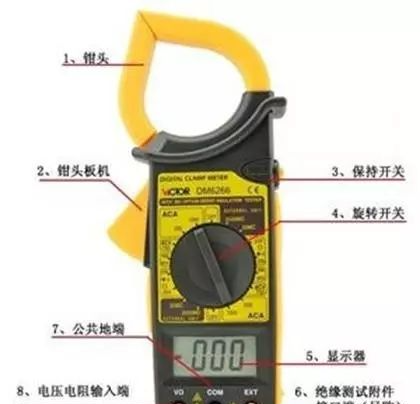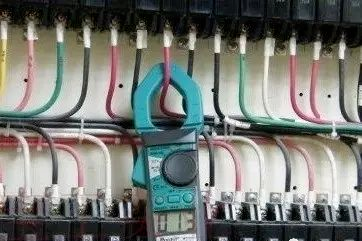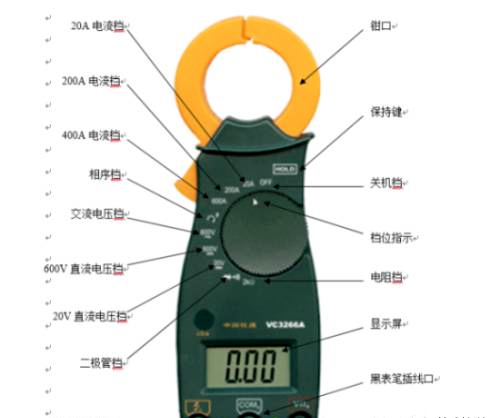

The clamp ammeter is composed of a current transformer and an ammeter. The core of the current transformer can open when the clamp is squeezed; the wire carrying the current to be measured can pass through the opening of the core without being cut. When the clamp is released, the core closes.

The clamp ammeter is composed of a current transformer and an ammeter. The core of the current transformer can open when the clamp is squeezed; the wire carrying the current to be measured can pass through the opening of the core without being cut. When the clamp is released, the core closes.
When we need to measure current without breaking the circuit, we need to use a clamp ammeter (sometimes abbreviated as clamp meter). A clamp ammeter is an instrument used to measure the magnitude of current in an operating electrical circuit and is a common measuring tool for electricians. Clamp ammeters are divided into clamp AC ammeters and clamp AC/DC ammeters, some of which can also measure AC voltage.
Structure:

The clamp AC ammeter is essentially composed of a current transformer and a rectifier-type instrument. The wire carrying the current to be measured acts as the primary winding of the current transformer, while the secondary winding is on the core of the transformer and is connected to the rectifier-type instrument. Based on a certain proportional relationship between the primary and secondary windings of the current transformer, the rectifier-type instrument can display the current value of the measured circuit.
The clamp AC/DC meter is an electromagnetic instrument, where the wire to be measured placed in the clamp acts as the excitation coil, forming a loop in the core. The electromagnetic measuring mechanism is located in the middle of the notch of the core, and it deflects under the influence of the magnetic field to obtain a reading. Since its deflection is not affected by the measured current, it can measure both AC and DC currents.
Usage Method:

The usage method of the clamp ammeter is simple, as shown in the figure above. To measure current, simply clamp the live wire being tested into the jaws of the clamp ammeter and then read the value on the digital display or dial.
It’s quite simple, right? Just clamp the measuring wire! However, the widespread use of digital clamp ammeters has added many multimeter functions, such as voltage, temperature, resistance, etc. (sometimes these multifunctional clamp meters are referred to as clamp multimeters, as shown in the figure above, the instrument has two probe sockets), and different functions can be selected using the knob, with usage methods similar to those of general digital multimeters. For specific function buttons, refer to the corresponding manual.

Phase Sequence Testing:
(1) Set the dial to the phase sequence detection position;
(2) Insert the probes yellow, black, and red into the c, COMb, VΩa sockets in order;
(3) Connect the red, black, and yellow probes to A, B, C (or L1, L2, L3) respectively. When connecting the red and black probes, the indicator light glows slightly; when the yellow probe is connected, the indicator light lights up, indicating a positive phase sequence; if the indicator light goes out, it indicates a reverse phase sequence;
(4) The phase sequence setting can also measure the phase-to-phase voltage.
AC Voltage Measurement:
(1) Set the dial to the AC voltage position;
(2) Insert the red and black probes into the VΩa, COMb sockets;
(3) Connect the other ends of the red and black probes to the test points and read the values.
AC Current Measurement:
(1) Select the appropriate current range;
(2) Fully clamp the wire to be measured with the jaws and read the data;
Note: The maximum test current of this instrument is only 600A; do not test currents exceeding 600A.
DC Voltage Measurement:
(1) Select the appropriate DC voltage range;
(2) Insert the red and black probes into the VΩa, COMb sockets;
(3) Connect the other ends of the red and black probes to the test points and read the values.
Resistance Measurement:
(1) Set the dial to the resistance range of 2kΩ;
(2) Insert the red and black probes into the VΩa, COMb sockets;
(3) Connect the other ends of the red and black probes to the test points and read the values;
Note: Resistance can only be tested when the circuit is powered off.
Continuity Measurement:
(1) Set the dial to the diode test position;
(2) Insert the red and black probes into the VΩa, COMb sockets;
(3) Connect the other ends of the red and black probes to the test points and read the values. If the value is very small and the multimeter beeps, the circuit is closed; otherwise, if the value displays “1” and the multimeter does not beep, the circuit is open or has a very high resistance.
Note: Continuity can only be tested when the circuit is powered off.
(1) Before using a digital multimeter, carefully read the user manual to familiarize yourself with the functions of the power switch, range switch, input sockets, various function keys, knobs, and accessories. Additionally, understand the multimeter’s limit parameters, and recognize the characteristics of overload displays, polarity displays, low voltage displays, and other warning indicators. Before measuring, carefully check for cracks in the probes, damage to the insulation of the leads, and ensure that the probes are correctly inserted to ensure operator safety.
(2) Before each measurement, double-check that the measurement item and range switch are set to the correct position and that the input sockets (or dedicated sockets) are selected correctly.
(3) Initially, the instrument may show jumping numbers; wait for the displayed value to stabilize before reading.
(4) Although the digital multimeter has a relatively complete protection circuit, avoid operational errors, such as measuring voltage with the current range, measuring voltage or current with the resistance range, or measuring charged capacitors with the capacitance range, to prevent damage to the instrument.
(5) If only the highest position displays the number “1” and the other positions are blank, it indicates that the instrument has overloaded; a higher range should be selected.
(6) Do not switch the range switch when measuring voltages above 10OV or currents above 0.5A, to avoid arcing and burning out the contacts of the switch.
(7) The numbers marked with danger next to the input sockets represent the limit values for the voltage or current that can be input into that socket. Exceeding these limits may damage the instrument and even endanger the operator’s safety.
(8) Clamp multimeters should not be used to measure currents in high-voltage lines; the voltage of the circuit being measured should not exceed the voltage level specified by the clamp meter (generally not exceeding 500 volts) to prevent insulation breakdown and electric shock.
(9) Assess the magnitude of the current to be measured and select the appropriate range; do not use a small range to measure large currents.
(10) Before measuring, ensure that the range switch is set to the appropriate AC current position; do not use the voltage or resistance range to measure current.
Remember! Never use the resistance range and current range to measure voltage; if done carelessly, it may burn out the meter.
(11) Only one wire can be clamped during each measurement. When measuring, place the wire being measured in the center of the clamp to improve measurement accuracy. It is best to hold the meter level and avoid letting the wire touch the clamp jaws and the meter body.
(12) After measurement, the range switch must be set to the maximum voltage range before turning off the power switch, to ensure safe use next time.

